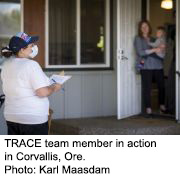- Navigating Your Midlife Crisis: Embracing New Possibilities
- City Raccoons Showing Signs of Domestication
- Mapping the Exposome: Science Broadens Focus to Environmental Disease Triggers
- One Week Less on Social Media Linked to Better Mental Health
- Your Brain Changes in Stages as You Age, Study Finds
- Some Suicide Victims Show No Typical Warning Signs, Study Finds
- ByHeart Formula Faces Lawsuits After Babies Sickened With Botulism
- Switch to Vegan Diet Could Cut Your Greenhouse Gas Emissions in Half
- Regular Bedtime Does Wonders for Blood Pressure
- Dining Alone Could Mean Worse Nutrition for Seniors
In Oregon, One Town Goes Door to Door Tracking Coronavirus Spread

A college town in Oregon is embarking on a groundbreaking effort to measure the hidden spread of COVID-19 within the community, thanks to the local university.
Oregon State University (OSU) researchers will fan out across Corvallis during the next four weekends, going to randomly selected houses and asking folks inside to provide nasal samples for testing.
The TRACE COVID-19 project is one of the first efforts in the nation to attempt to assess an entire community’s COVID-19 activity, officials said.
The team hopes to have just under 4,000 samples by the end, enough to paint a statistically accurate picture of how widespread the COVID-19 virus has become in the town of 58,641, said OSU spokesman Steve Clark.
“We’ll have an indication of the presence of the virus among those who are symptomatic and asymptomatic,” Clark said. “This will give a community-wide profile of Corvallis’ COVID health.”
The effort is aimed at providing the kind of data that Oregon Gov. Kate Brown will need to have in hand when planning how to reopen the state from its weeks-long lockdown, Clark said.
One of the problems with tracking the spread of COVID-19 has been that many infected people don’t have any symptoms, while others have symptoms so mild that their infection is missed, said Ben Dalziel, an assistant professor with the OSU College of Science.
“We are flying blind in many ways because we do not know how many people are infected with the virus and how that is changing over time,” Dalziel said in a university statement. “Without this knowledge, it is much more difficult to implement effective control measures and to forecast the spread of the disease. Right now, we are managing the pandemic mostly looking in the rearview mirror.”
Each weekend, the OSU team aims to gather samples from 960 different people.
Here’s a video of showing how testing is done:
Researchers will knock on a household’s door and ask those folks inside to take part. Each person who volunteers will be given a test kit — a cotton swab that they run around the inside of their nose themselves, and a tube to store it in afterward.
“Our team members never come into physical contact with the individuals in a household. The kit is returned on the doorstep of the household” while the researchers wait, Clark explained.
A private lab will test each sample for COVID-19, and confidentially provide the results to the individual person and to the county health department as required by law, Clark said. Results are expected to be available in seven to 10 days.
The OSU team will receive aggregated results from the testing lab and report them for each week’s testing, as well as a final report summing up all of the data for Corvallis, Clark said.
If successful, the OSU researchers plan to expand their work to other Oregon cities and towns, he said.
They also plan to perform random antibody testing in Corvallis and elsewhere in the near future, Clark said.
The current test only can detect the active presence of live virus, but antibody testing can detect whether a person has had COVID-19 in the past.
Dr. Amesh Adalja, a senior scholar with the Johns Hopkins Center for Health Security, agreed that “efforts to do wide-based community sampling for the coronavirus can help aid understanding of where this virus has been and what risk remains in a population.” Adalja was not part of the study.
“This will help us to understand what the true hospitalization rate is, a factor that influences social distancing recommendations and hospital capacity planning,” he continued. “It will also help to determine the true case fatality ratio as well.”
Governors across the United States will need such data to responsibly relax the lockdowns that have stemmed the tide of coronavirus that has rolled across the country, Adalja added.
“Knowing that a community has already been largely impacted by the virus can help to inform decisions regarding the need for continuing specific social distancing measures,” Adalja said.
More information
Oregon State University has more about the TRACE COVID-19 project.
Source: HealthDay
Copyright © 2025 HealthDay. All rights reserved.










